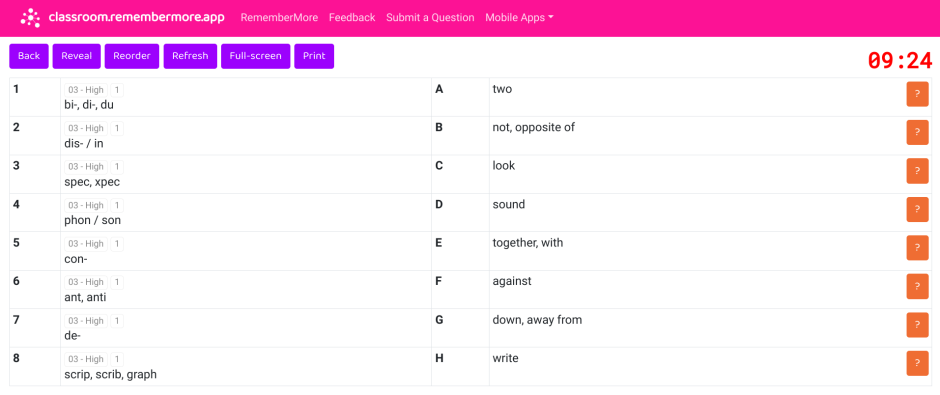Last year, I had one period per week with four Year 8 pupils to support their English lessons. I did not have any prior experience of teaching Year 8 English at the school. So what did we do?
I reviewed the scheme of learning and spoke with their teacher(s). Each week we “looked ahead” to what was coming the following week and prepared them for lessons. The final 10 minutes was spent investigating word morphology (the study of words and their parts) to help these four pupils understand and make connections between words. There is good evidence to be interesting in morphology, studies have found that explicit teaching of morphology can have a positive impact on reading comprehension; including significant progress for pupils with English as an Additional Language (Amirjalili & Jabbari, 2018). There is also evidence that explicitly teaching pupils the patterns for morphemes had a significant effect on improving decoding and phonological awareness (Goodwin & Anh, 2013).
Phase 1
I didn’t not know which roots to use, so after a little investigating I came up with a 99 flashcard deck – Roots, Prefixes and Suffixes. I had not specifically tied it to the Year 8 curriculum – and should have. That said, it was rather successful and the pupils would often enthusiastically report back the following week when they had bumped in a familiar word part. Their enthusiasm struck a chord. This time around I based the deck on the frequency of the root, prefix or suffix.
Phase 2
As you know, knowing the meanings of these word roots can provide a great foundation for expanding your English vocabulary and understanding the meaning of many words. I now have a more trusted roots list. Although many articles distinguish between Greek and Latin, I am not sure it matters too much for learners / readers.
It’s difficult to give an exact percentage of how many English words are derived from these roots as many words can be derived from multiple roots or have complex etymologies, however, here’s is a rough estimate:
| Port: around 0.5% of English words. Scrip, scrib: around 3.5% of English words. Duc: around 1.5% of English words. Phon: around 4.5% of English words. Spec, xpec: around 2.5% of English words. Ant, anti: around 2.5% of English words. Pos: around 1.5% of English words. Bio: around 1.5% of English words. Vis, vid: around 2.5% of English words. Jec: around 0.5% of English words. Graph: around 1.5% of English words. Ac, ag: around 1.5% of English words. Ven: around 0.5% of English words. | Sens, sent: around 1.5% of English words. Struc: around 1.5% of English words. Voc, vok: around 1.5% of English words. Met: around 1.5% of English words. Gram: around 1.5% of English words. Arch: around 1.5% of English words. Trac: around 1.5% of English words. Sign: around 1.5% of English words. Chron: around 1.5% of English words. Val: around 0.5% of English words. Son: around 1.5% of English words. Vert, vers: around 1.5% of English words. Mono: around 0.5% of English words. |
Therefore, if you knew these 26 word roots, you would have a good understanding of somewhere in the region of 42% of all words in the English language. Even if that calculated estimate is off a little – that is still mind blowing!
Which got me thinking… the “Dirty Thirty” deck of most common spellings continue to be used frequently. What about “Nifty Fifty” morphology?
After a day of research and curation I went with “Unlock the English Language” – a deck of 52 flashcards (1 a week) or in 6 half-term clusters that unlocks approximately 90% of the curriculum vocabulary.

Open and available via Classroom and RememberMore.
Phase 2 update after week 1
One week into the new term. Here is an update on the introduction of ‘Unlock the English Language’ deck.
As the cued response is very short / quick to recall – we are using A/Q more in class than previously. We are asking pupils to recall an associated word along with the target cue. For example ex- leads to “out / exit,” and “out leads to ex- and exit.”
Year 7 – In class, daily quizzing. A cluster (8 cards) set for homework. Clusters set accumulatively. We also quiz on the class text Holes. I also bumped into two pupils in prep on Monday. We “played” for most of the forty minute prep session. Securing cluster 1 and 2 and exploring 3 (26 cards). Friday’s test was very positive. The pupils were very keen to push on with cluster 2. Test results on Friday with high both Q/A and A/Q. Pupils have reporting bumping into roots and prefixes in their lessons.
Year 8 – In class, daily quizzing. A cluster (8 cards) set for homework. Clusters set accumulatively. By the third lesson, pupils wanted to push on with cluster 2. Friday we tested clusters 1 and 2 – two rounds of 10 cards, Q/A and A/Q. Scores were high, two pupils had did not do their 20 mins homework. Their scores were 12/ 17 and 10/17. A few pupils have already moved on to remember the complete deck.
Phase 2 update after week 2
We now have clusters 1, 2 and 3 bedded in. Mean scores for Q/A (18.2) and A/Q (17.6) are very similar. With 26 cards, selections have sufficient breadth to be fun or random, however games of ‘Last Person Standing’ are lasting too long, so we are adding in terms from cluster 4.
Using term-definition and exemplification is proving very powerful. This insight has highlighted the potential for this extra element or routine to be applied for any single word definition flashcards eg the word cue, and diagnostic definition plus a synonym or antonym.



